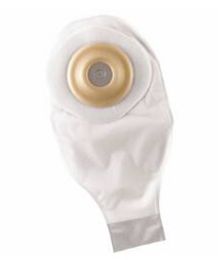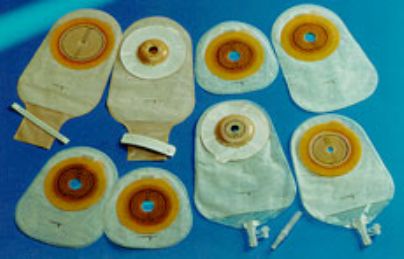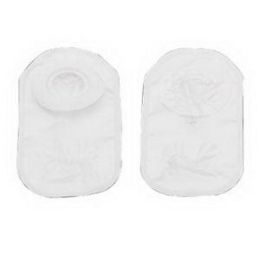


























.jpg&newheight=260&quality=80)

What is an Ostomy Bag?
An ostomy bag refers to a plastic pouch that is connected to the end of an abdominal stoma to allow excrement to be caught and stored. The bag is made to be leak-proof and features a tight seal directly onto the skin, or in a two piece system. Occasionally, an ostomy bag is made from material other than plastic, such as fabric or rubber. There are two main types of ostomy bags. The first type is available in one piece which sticks directly onto the skin with adhesive. The bag and the adhesive base plate are altogether, they cannot be separated. The other type attaches to a tube or seal that then attaches to the skin. Both are effective at preventing leaks and protecting the skin.
Some individuals may use a separate ostomy bag for daytime and nighttime use. Nighttime bags can be connected to a larger container that is used to catch the waste. This enables the bag to not require changing until morning. During the day, an individual can see when the pouch is getting full, and know when the bag needs to be replaced.
To change an ostomy bag, the user should sit or lean over a toilet. To allow the bag to be emptied, there is usually a closure located on it which can be opened. When sitting on the toilet, it is best to spread the legs wide enough to let the bag empty between them. Lower the bag slowly toward the toilet bowl and allow the contents to drain out. To clean any spills around the bowl’s rim, cleaners, disinfectant towels, or rags may be required.
Some users may only need an ostomy bag temporarily, as there are options for rerouting the intestines back to normal so the bowels can empty naturally. Others may need to use the bag permanently. There are a variety of bags that are lightweight to avoid skin irritation during movement, and that stick very close to the skin so they are discreet under clothing. When choosing an ostomy bag, overall comfort is an important consideration.
What is an Ileostomy Bag?
An ileostomy is a surgical procedure in which the small intestine is attached to the abdomen. This produces an artificial opening called a stoma and the waste exits the body through this stoma. An ileostomy can be temporary or permanent, depending on the degree of illness. Another factor in determining whether the ileostomy will be permanent or not is often personal choice and lifestyle.
One-piece ileostomy bags are made to be completely disposable. The bag itself and the wafer that attaches it to the skin are permanently connected. These bags often come with tape to help the wafer stick to the skin. But, many users find the tape is irritating to the skin, so the wafer is designed to adhere to the skin without it. One-piece systems are often easier to apply, and appear less bulky under clothing than a two-piece system.
What is a Urostomy Bag?
A urostomy is a surgical procedure that creates an alternative way for urine to exit the body. During the procedure, the bladder may be bypassed or removed. A small portion of the bowel is used to make a route for the urine to travel from the kidneys to an opening in the abdominal wall, called a stoma. A urostomy bag is attached to the stoma to collect the urine on the outside of the body.
While various conditions and illnesses may indicate the need for a urostomy, the most common cause is bladder cancer. Injuries to the bladder may also require a temporary urostomy, such as trauma. Those who have a spinal cord injury may need the surgery, also. Using a urostomy bag properly prevents leakages from happening, and there are different types of bags available, such as pre-cut pouches and reusable designs. There are also different types of adhesives used to attach the bag to the skin.
What is a Colostomy Bag?
A colostomy bag, typically removable and disposable, is used to collect and dispose of waste from the body. It is attached to a stoma, which leads from the inner abdomen to the outside of the body to deposit the large intestinal waste into. A colostomy bag is only a temporary measure in many cases.
There are several conditions that may cause a need for a colostomy. Among these are deformation of the anal opening, nerve conditions that keep the bowel from functioning as it should, and necrotizing enterocolitis, which is a type of inflammatory bowel disease. When a person has an injury or infection and the colon needs time to heal, sometimes colostomy surgery is performed. Often, it is a life-saving surgery, because without it a person could die.
After the colon heals, a colostomy can be reversed so an individual can go back to the normal way of moving fecal matter out of the body. In other cases, a permanent colostomy may be required with a colostomy bag being worn all the time. This may occur when the colon muscles are not in good working order and cannot be controlled when feces leaves the body.
How do I Change a Colostomy Bag?
The steps needed to change a colostomy bag depend on the type of bag being used. In general, first remove the old bag, clean the area that surrounds the stoma, then attach a clean bag. To clean the area, use a clean cloth, soap and warm water. Cleaning properly is important not only for sanitary reasons, but to ensure the adhesive will stick to the skin. Allow the skin to dry completely before applying a new bag.
To apply a stick-on type of colostomy bag, make sure the wax that allows the bag to stick to the skin fits around the stoma. The wax may need to be trimmed a bit to ensure a good fit. Then, press the opening that has the wax against the dry skin and apply stoma paste around it for a good seal. Be sure to clamp the bottom of the bag shut after changing it. Some individuals shave the area around the stoma before applying a new bag. This helps keep the area clean, and prevents pulling out hairs when changing a colostomy bag.
Rehabmart is pleased to offer superior quality one-piece ostomy systems from credentialed and experienced vendors comprising McKesson Medical-Surgical and Independence Medical.
Hulet Smith, OT
Rehabmart Co-Founder & CEO
lb